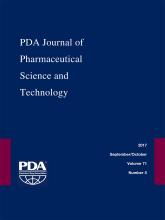Research ArticleResearch
Extractables Screening of Polypropylene Resins Used in Pharmaceutical Packaging for Safety Hazards
Dennis Jenke
PDA Journal of Pharmaceutical Science and Technology September 2017, 71 (5) 346-367; DOI: https://doi.org/10.5731/pdajpst.2016.007401

Reference
- 1.↵ISO 10993-12:2012(E). Biological Evaluation of Medical Devices—Part 12: Sample Preparation and Reference Materials. Fourth edition, 2012-07-01.
- 2.↵
- Cramer G. M.,
- Ford R. A.,
- Hall R. L.
- 3.↵Toxtree (Estimation of Toxic Hazard—A Decision Tree Approach), Version 2.6.0. Ideaconsult Ltd.: Sofia, Bulgaria.
- 4.↵
- Benigni R.,
- Bossa C.,
- Jeliakova N.,
- Netzeva T.,
- Worth A.
- 5.↵University of California, Berkeley. Carcinogenic Potency Database. Available at http://toxnet.nlm.nih.gov/cpdb/chemnameindex.html. Updated October 3, 2007. Accessed September 27, 2016.
- 6.↵Toxnet Toxicology Data Network, Chemical Carcinogenesis Research Information (CCRIS). Available at http://toxnet.nlm.nih.gov/cgi-bin/sis/htmlgen?CCRIS. Accessed September 27, 2016.
- 7.
- Li K.,
- Rogers G.,
- Nashed-Samuel Y.,
- Lee H.,
- Mire-Sluis A.,
- Cherney B.,
- Forster R.,
- Yeh P.,
- Markovic I.
- 8.European Chemicals Agency EC# 402-140-1 entry for CAS 17865-32-6. Exp Supporting Repeated Dose Toxicity: Oral. 002. http://www.echa.europa.eu/web/guest/registration-dossier/∼/registered-dossier/8528.
- 9.Dicyclopentylsilanediol [CAS No. 211495-85-1]. Abstract for 90-day Repeat Dose Oral Toxicity Study in Rats. Kashima Laboratory, Mitsubishi Chemical Safety Institute Ltd. (14 Sunayama, Hasaki-machi, Kashima-gun, Ibaraki, 314-0255, Japan).
- 10.OECD HPV Chemical Programme, SIDS Dossier, Benzoates. Available at http://webnet.oecd.org/HPV/UI/SIDS_Details.aspx?key=78d737a4-1363-4f31-8de6-9a0c4225c240&idx=0. Accessed on March 10, 2014.
- 11.Hazardous Substances Database (HSDB). Nonanoic Acid CAS No. 112-05-0. Hazardous Substances Databank Number 5554. Late revision date: October 7, 2008.
- 12.
- 13.IUCLID Dataset. Myristic Acid, pure. CAS Registry No. 544-63-8) EINCES No. 208-875-2. European Commission—European Chemicals Bureau. January 23, 2008.
- 14.
- 15.IUCLID Dataset on fatty acids, rape oil. European Commission–European Chemical Bureau. February 19, 2000.
- 16.Safety Data Sheet, Stearic Acid. Product code 10011298. CAS # 57-11-4; RTECS No. WI2800000. Cayman Chemical Co., 1180 E. Ellsworth Rd, Ann Arbor, MI, 48108. Revision date 07/20/2015.
- 17.Japan Existing Chemical Data Base. 2,4-Di-ter-butylphenol. http://dra4.nihs.go.jp/mhlw_data/home/file/file96-76-4.html. Accessed April 6, 2011.
- 18.United Nations Environmental Program. 2,6-di-tert-butyl-p-cresol (BHT) CAS No 128-37-0 http://www.inchem.org/documents/sids/sids/128370.pdf. Accessed April 12, 2011. Article reference: DFG (1985): Toxikologisch-arbeitsmedizinische Begründung von MAK-Werten – Butylhydroxytoluol (BHT), Deutsche Forschungsgemeinschaft (DFG), VCH Weinheim.
- 19.
- Takahashi O.
- 20.Screening-Level hazard Characterization of High Production Volume Chemicals. Tris(2,4-di-(tert)-butylphenylphosphite (CAS No. 31570-04-4). December 2007. Interim. Prepared by the High Production Volume Chemicals Branch, Risk Assessment Division, Office of Pollution Prevention and Toxics, Environmental Protection Agency, Washington, DC.
- 21.European Chemicals Agency EC#204-009-2 entry for CAS 112-84-5. (Z)-Docos-13-enamide. Exp Key Repeated dose toxicity: Oral.001. http://apps.echa.europa.eu/registered/data/dossiers/DISS-98762a7c-c98a-014e-e044-00144f67d031/AGGR-6c9d6a4d-ceff-4d77-97a9-f0c6eb07c935_DISS-98762a7c-e98a-014e-e044-00144f67d031.html#AGGR-6c9d6a4d-ceff-4d77-97a9-f0c6eb07c935.
- 22.Registry of Toxic Effects of Chemical Substances (RTECS). Urea. CAS Registry No. 57-13-6. RTECS No. YR6250000. Review date: July, 2013.
- 23.OECD SIDS Initial Assessment Report for SIAM 14. Glycerol, CAS Number 56-81-5. Sponsor Country: United Kingdom. Submitted February, 2002.
- 24.Safety Data Sheet, Dithiothreitol. Product code. CAS # 3483-12-3; RTECS No. EK1610000. Fisher Scientific, 1 Research Lane, Fair Lawn, NJ, 48108. Revision date 07/29/2008.
- 25.IUCLID Dataset. Dodecan-1-ol. CAS Registry No. 112-53-8. EINECS No. 203-982-0. European Commission–European Chemicals Bureau. February 18, 2000.
- 26.European Chemicals Agency. (Publication dated 1982 [Gorzinski et al, 1982]). REACH registration dossier for dodecyl acrylate CAS No.: 2156-97-0. Read across Subs Supporting Repeated Dose Toxicity: oral.003. Accessed July 1, 2014.
- 27.
- Yamada A.
- 28.National Toxicology Program. 1984. Diethyl phthalate: Reproduction and Fertility Assessment in CD-1 Mice When Administered in the Feed. NTP-84-262. U.S. Department of Health and Human Services, National Institutes of Health, NTP, National Institute of Environmental Health Sciences, Research Triangle Park, NC. NTP Report No. RACB83092. Abstract available at http://ntpserver/niehs.nih.gov/index.cfm?objectid=071C4778-DDD3-7EB0-D932FD19ABCD6353.
- 29.IUCLID Dataset. Octandecan-1-o1. CAS Registry No. 112-92-5. EINECS No. 204-017-6. European Commission–European Chemicals Bureau. February 18, 2000.
- 30.Safety Data Sheet, ATMER™ 163. Product code AEK2311. Registration No. 01-2119548392-37-0000. Substance No. 276-014-8. Croda Europe Ltd., Cowick Hall, Snaith, DN14 9AA Goole. Version 1; Revision date 07/12/2010.
- 31.OECD SIDS Initial Assessment Report for SIAM 18. Soluble Silicates. Sponsor Country: Germany. Submitted January, 2004.
- 32.↵Guidance for Industry. M7 Assessment and Control of DNA Reactive (Mutagenic) Impurities in Pharmaceuticals to Limit Potential Carcinogenic Risk. U.S. Department of Health and Human Services, Food and Drug Administration: Rockville, MD, May, 2015.
- 33.↵International Conference on Harmonization of Technical Requirements for Registration of Pharmaceuticals for Human Use. Draft Consensus Guideline. Guideline for Elemental Impurities. Q3D. Current Step 4 Version, December 16, 2014.
- 34.↵
- Jenke D. R.
- 35.↵
- Jenke D. R.
- 36.↵
- Jenke D. R.
- 37.↵
- Jenke D. R.,
- Stults C. L. M,
- Paskiet D. M.,
- Ball D. J.,
- Nagao L. M.
- 38.↵
- Jenke D.,
- Couch T. R.,
- Robinson S. J.,
- Volz T. J.,
- Colton R. H.
- 39.↵
- Broschard T. H.,
- Glowienke S.,
- Bruen U. S.,
- Nagao L. M.,
- Teasdale A.,
- Stults C. L.,
- Li K. L.,
- Iciek L. A.,
- Erexson G.,
- Martin E. A.,
- Ball D. J.
- 40.↵Integrated Risk Information System, U.S. Environmental Protection Agency. Boron (CASRN 7440-42-8). August 5, 2004. Available at http://www.epa.gov/iris/subst/0410.htm.
- 41.↵Expert Group on Vitamins and Minerals. EVM/99/23/P—Review of Boron. November, 1999. Available at http://archive.food.gov.uk/dept_health/pdf/evmpdf/evm9923.pdf.
- 42.↵
- Jenke D. R.
- 43.↵USP. <1661> Evaluation of Plastic Packaging Systems and their Materials of Construction with Respect to Their User Safety Impact. USP39-NF 34; pp 1823–1827. Official May 1, 2016.
In This Issue
PDA Journal of Pharmaceutical Science and Technology
Vol. 71, Issue 5
September/October 2017
Extractables Screening of Polypropylene Resins Used in Pharmaceutical Packaging for Safety Hazards
Dennis Jenke
PDA Journal of Pharmaceutical Science and Technology Sep 2017, 71 (5) 346-367; DOI: 10.5731/pdajpst.2016.007401
Jump to section
Related Articles
- No related articles found.





